
a web page by Don Roberson |
CUCKOO-SHRIKES Campephagidae |
|
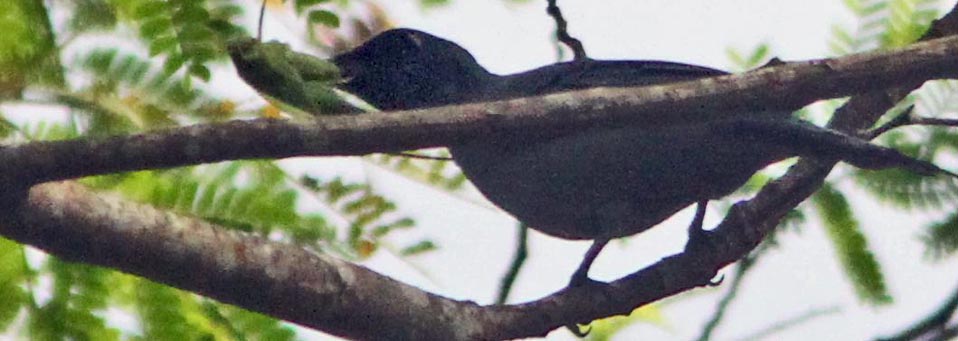 |
Traditionally, fully 50 species (60% of the family) were assigned to the single genus Coracina. Recent genetic evidence (Fuchs et al. 2007) has shown genus Coracina to be paraphyletic, and the traditional genus is actually composed of at least five unrelated lineages. The cicada-birds — named for the cicada-like vocalizations of some of them -- are or will be assigned to genus Edolisoma, far removed from the pared-down Coracina genus of ~27 species. |
The old way of looking at cuckoo-shrikes was to think of them in three main groups of cuckoo-shrikes: the cuckoo-shrikes in 5 genera, trillers in genus Lalage, and minivets in genus Pericrocotus; e.g., Handbook of Birds of the World (Taylor 2005). Now, after a review of mtDNA and nuclear DNA sequences, the evolutionary history of cuckoo-shrikes is more complex. At the base of the lineage are the minivets in genus Pericrocotus; then the core Coracina cuckoo-shrikes, followed by African cuckoo-shrikes in two genera (Campephaga, Lobotos); and then more recent groups, like the trillers in genus Lalage, various isolated (and sometimes endangered) cuckoo-shrikes from the Philippines to Wallacea, and finally the cicadabirds, which range from Australia and New Guinea north into Polynesia and west into Wallacea. |
Minivet phylogeny was examined by the molecular study of Jønsson et al. (2009), who found they evolved in Asia and eventually dispersed to Indonesian islands. Plumage characters were considered very "plastic," and examples of convergent evolution, as opposed to indicating relationships. |
 |
 |
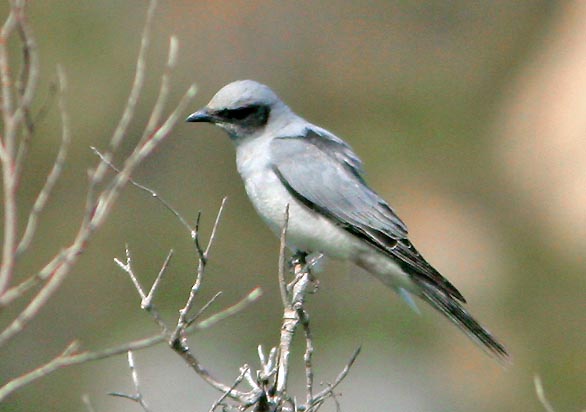 The "core cuckoo-shrikes" are those in genus Coracina, exemplified here by White-rumped Cuckoo-shrike (above), a Sulawesi endemic that prefers lowland woods and swamp-forests, and Black-faced Cuckoo-shrike
of Australia (right). The latter is widespread in Australia, mostly in
open country, and ranges in color from rather pale (e.g., this bird
from southwest Australia, race subpallida) to darker in the east. Some
populations are migratory and spend the austral winter northwards in
New Guinea or Indonesia. The Ground Cuckoo-shrike C. maxima
of the dry interior of Australia forages for insects and arthropods
primarily on the desert floor. Most cuckoo-shrikes, though, are
arboreal in tropical forest. One of those is Cerulean Cuckoo-shrike
(below), another Sulawesi endemic. It lives in small parties in montane
forests and almost nothing is known about its life history. The "core cuckoo-shrikes" are those in genus Coracina, exemplified here by White-rumped Cuckoo-shrike (above), a Sulawesi endemic that prefers lowland woods and swamp-forests, and Black-faced Cuckoo-shrike
of Australia (right). The latter is widespread in Australia, mostly in
open country, and ranges in color from rather pale (e.g., this bird
from southwest Australia, race subpallida) to darker in the east. Some
populations are migratory and spend the austral winter northwards in
New Guinea or Indonesia. The Ground Cuckoo-shrike C. maxima
of the dry interior of Australia forages for insects and arthropods
primarily on the desert floor. Most cuckoo-shrikes, though, are
arboreal in tropical forest. One of those is Cerulean Cuckoo-shrike
(below), another Sulawesi endemic. It lives in small parties in montane
forests and almost nothing is known about its life history. |
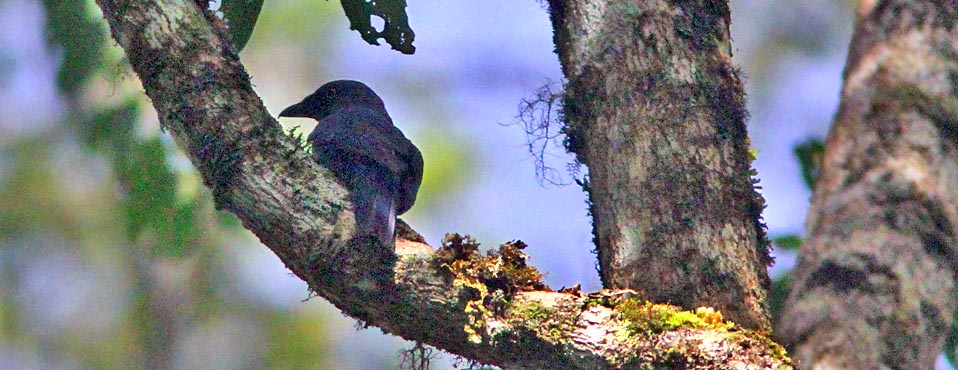 |
 |
In contrast to the quiet behavior of Bar-bellied, the Moluccan Cuckoo-shrike (left), endemic to the Moluccas of Wallacea, is large and raucous. My impression of it in the field was that it behaved like a large blackish-and-white jay in the New World tropics. A further set of cuckoo-shrikes, mostly assigned to genus Campephaga, reside in the African tropics. Here they are rather secretive and difficult to see. They, too, often show substantial sexual dimorphism. The male Black Cuckoo-shrike is all-black, but the female Black Cuckoo-shrike (below, in a nice photo by Ed Harper), wears a lovely scalloped plumage of muted browns. |
 |
 While
most cuckoo-shrikes today are resident species, the family has shown a
remarkable ability to disperse to islands far out to sea. There are
small cuckoo-shrikes on such remote islands as Madagascar, Mauritius,
and Reunion in the Indian Ocean, and the molecular evidence shows they
got there via Asia, not Africa, long ago (Fuchs et al. 2007). The
genetic evidence proved these were not "Coracina" cuckoo-shrikes, as
they had traditionally been assigned, but that they are with the Lalage
clade that had previously been thought to be composed only of trillers.
These Indian Ocean taxa are small cuckoo-shrikes, mostly gray-and-white
males [e.g., male Reunion Cuckoo-shrike, left] with rufous or
brown-barred females, and in that sense rather like the pied patterns
in male trillers (with browner females). While
most cuckoo-shrikes today are resident species, the family has shown a
remarkable ability to disperse to islands far out to sea. There are
small cuckoo-shrikes on such remote islands as Madagascar, Mauritius,
and Reunion in the Indian Ocean, and the molecular evidence shows they
got there via Asia, not Africa, long ago (Fuchs et al. 2007). The
genetic evidence proved these were not "Coracina" cuckoo-shrikes, as
they had traditionally been assigned, but that they are with the Lalage
clade that had previously been thought to be composed only of trillers.
These Indian Ocean taxa are small cuckoo-shrikes, mostly gray-and-white
males [e.g., male Reunion Cuckoo-shrike, left] with rufous or
brown-barred females, and in that sense rather like the pied patterns
in male trillers (with browner females). |
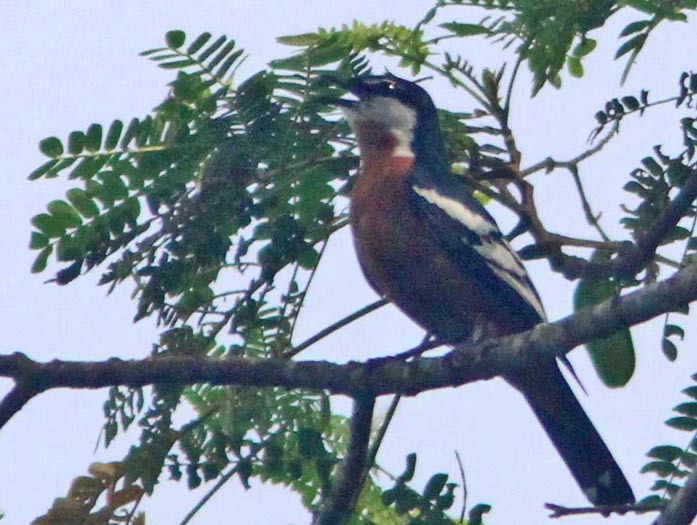 There are about 13 trillers in genus Lalage,
mostly on islands from the Philippines to New Guinea and Melanesia.
Some black-and-white species are birds of beaches, mangroves, or open
country, but others forest-edge species, like Rufous-bellied Triller of Halmahera and satellite islands in Wallacea (singing male, right). St. Matthias Triller L. conjuncta is a forest bird confined to Mussau I. in the St. Matthias group in the Bismarck Archipelago, Melanesia. There are about 13 trillers in genus Lalage,
mostly on islands from the Philippines to New Guinea and Melanesia.
Some black-and-white species are birds of beaches, mangroves, or open
country, but others forest-edge species, like Rufous-bellied Triller of Halmahera and satellite islands in Wallacea (singing male, right). St. Matthias Triller L. conjuncta is a forest bird confined to Mussau I. in the St. Matthias group in the Bismarck Archipelago, Melanesia. |
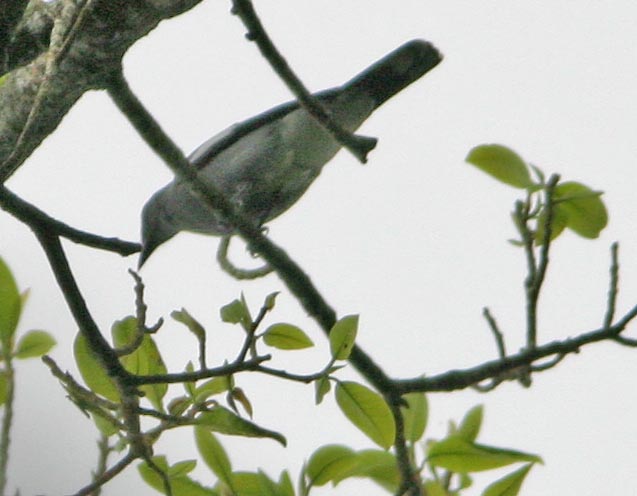 Finally,
there are a few unique species assigned to their own genera or to small
clades of mostly island species. Golden Cuckoo-shrike Campochaera sloetii of montane New Guinea is a striking bird of golden-yellow, the only one with such color within the family. Blue Cuckoo-Shrike Cyanograucalus azureus
of the jungles of west Africa and the Congo Basin is a brilliant glossy
blue, again unique in the Campephagidae. Pygmy Cuckoo-shrike Celebesica abbotti is a small and unique species that joins mixed feeding flocks in montane Sulawesi. White-winged Cuckoo-shrike
(left) is also a mountain cloud-forest specialist, from Negros, Panay,
and Guimaras in the central Philippines, where it is now considered
Endangered. Finally,
there are a few unique species assigned to their own genera or to small
clades of mostly island species. Golden Cuckoo-shrike Campochaera sloetii of montane New Guinea is a striking bird of golden-yellow, the only one with such color within the family. Blue Cuckoo-Shrike Cyanograucalus azureus
of the jungles of west Africa and the Congo Basin is a brilliant glossy
blue, again unique in the Campephagidae. Pygmy Cuckoo-shrike Celebesica abbotti is a small and unique species that joins mixed feeding flocks in montane Sulawesi. White-winged Cuckoo-shrike
(left) is also a mountain cloud-forest specialist, from Negros, Panay,
and Guimaras in the central Philippines, where it is now considered
Endangered. |
Photos: The male Common Cicadabird Edolisoma tenuirostris had caught a katydid at Foli, Halmahera, Indonesia on 10 Oct 2011. The female Sulawesi Cicadabird E. morio was at Dumoga-Bone NP, Sulawesi, Philippines, on 4 Oct 2011. The male Long-tailed Minivet Pericrocotus ethologus was at Walsingham, Hebei, China, on 10 June 2004. The male Small Minivet P. miniatus was at Ranthambhore, India, in Mar 2001. The male Fiery Minivet P. igneus was at St. Pauls NP, Palawan, Philippines, in Dec 2005. The White-rumped Cuckoo-shrike Coracina leucopygia was at Tangkoko NP, Sulawesi, Indonesia on 14 Oct 2011. The Black-faced Cuckoo-shrike C. novaehollandiae subpallida was at Waychinicup NP, Western Australian, in Aug 2008. The male Cerulean Cuckoo-shrike C. temminckii was at Lore Lindu NP, Sulawesi, Indonesia, on 28 Sep 2011. The plain-bellied Bar-bellied Cuckoo-shrike Coracina striata mindorensis was at Sablayan, Mindoro, Philippines in Dec 2005. The Moluccan Cuckoo-shrike C. atriceps was at Foli, Halmahera, Indonesia, on 8 Oct 2011. W. Ed Harper photographed the female Black Cuckoo-shrike Campephaga flava at Arusha NP, Tanzania, in July 1998. The male Reunion Cuckoo-shrike Lalage newtoni was on Reunion on 4 Dec 1992. The singing male Rufous-bellied Triller Lalage aurea was at Foli, Halmahera, Indonesia, on 10 Oct 2011. The White-winged Cuckoo-shrike Analisoma ostenta was atop Mt. Canloan, Negros, Philippines, in Dec 2005. All photos © Don Roberson, except for that attributed © W. Ed Harper, and used with permission; all rights reserved. Bibliographic note: There is no "family book" per se, but a nice introduction to this family, with some excellent photos, is in Taylor (2005). Literature cited:
|
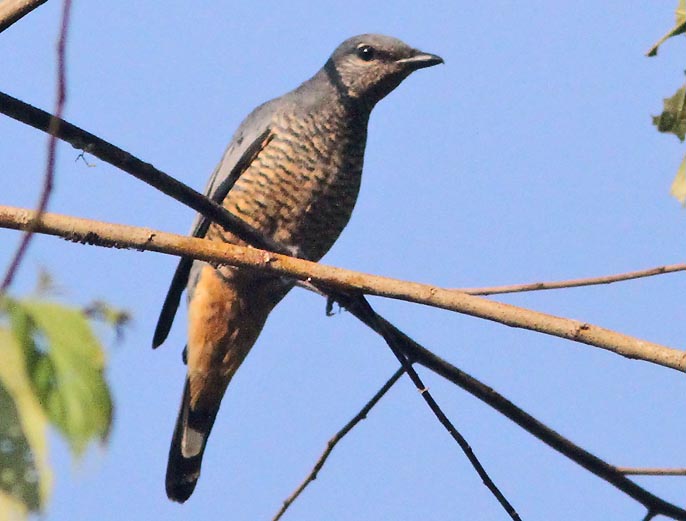 Cuckoo-shrikes
are fairly large family of mostly arboreal birds of corvoid origin in
the Old World, and mostly in the tropics. The family is centered in
Australasia and southeastern Asia, and particularly in the islands from
Borneo and the Philippines through Indonesia to New Guinea. Examples
include Common Cicadabird (male above, having just caught a large grasshopper) and Sulawesi Cicadabird
(left, a female). A goodly number of cuckoo-shrikes are sexually
dimorphic, with solid-colored males that are black or gray, and females
that are often barred below, and many have rufous underparts.
Cuckoo-shrikes
are fairly large family of mostly arboreal birds of corvoid origin in
the Old World, and mostly in the tropics. The family is centered in
Australasia and southeastern Asia, and particularly in the islands from
Borneo and the Philippines through Indonesia to New Guinea. Examples
include Common Cicadabird (male above, having just caught a large grasshopper) and Sulawesi Cicadabird
(left, a female). A goodly number of cuckoo-shrikes are sexually
dimorphic, with solid-colored males that are black or gray, and females
that are often barred below, and many have rufous underparts. 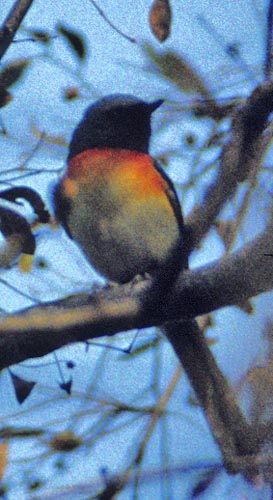
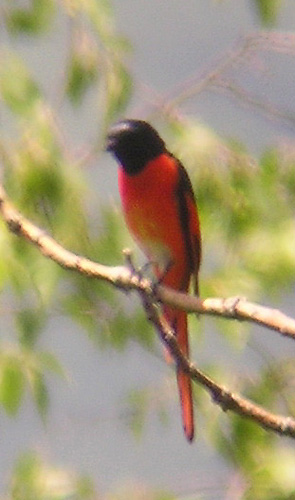 The earliest and most colorful group are the minivets of southeastern Asia. Some are lowland residents, like Fiery Minivet of the Malay Peninsula, Sumatra, Borneo, and Palawan (below, a male), or mostly resident, such as Small Minivet of India and much of southeast Asia (far right, a male), but others are long-distance migrants. Long-tailed Minivet
(near right, a male) migrates from China and the Himalayas to the
lowlands of India and southeast Asia for winter. The males of all these
minivets are extensively red or orange, but females are either yellow
below (i.e., Fiery and Long-tailed) or gray-and-white (Small Minivet).
Sexual dimorphism is a prominent character of most minivets. Some of
the most migratory, though, such as Ashy Minivet Pericrocotus divaricatus,
are more soberly patterned in gray-and-white in both male and female
plumages. That species breeds far north into Japan, Korea, and eastern
Siberia.
The earliest and most colorful group are the minivets of southeastern Asia. Some are lowland residents, like Fiery Minivet of the Malay Peninsula, Sumatra, Borneo, and Palawan (below, a male), or mostly resident, such as Small Minivet of India and much of southeast Asia (far right, a male), but others are long-distance migrants. Long-tailed Minivet
(near right, a male) migrates from China and the Himalayas to the
lowlands of India and southeast Asia for winter. The males of all these
minivets are extensively red or orange, but females are either yellow
below (i.e., Fiery and Long-tailed) or gray-and-white (Small Minivet).
Sexual dimorphism is a prominent character of most minivets. Some of
the most migratory, though, such as Ashy Minivet Pericrocotus divaricatus,
are more soberly patterned in gray-and-white in both male and female
plumages. That species breeds far north into Japan, Korea, and eastern
Siberia. 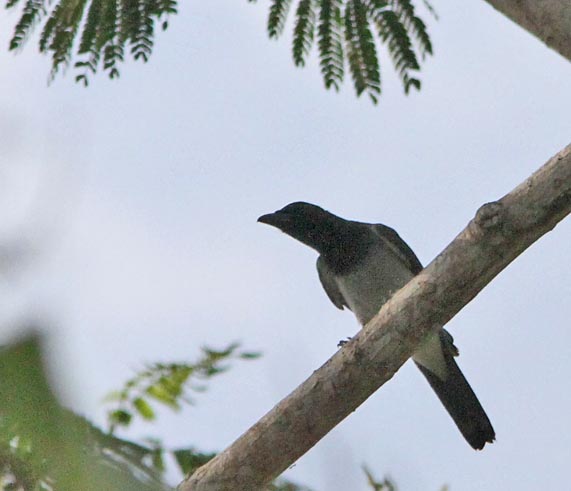 Not only do the Coracina cuckoo-shrikes vary in habitat and behaviour, but they vary in size. Bar-bellied Cuckoo-shrike
(above) is small and slim. It range as currently defined runs from the
Malay Peninsula to Sumatra, Borneo, and the Philippines. In the
Philippines there are several races that are all gray below — like this
one (above) of race mindorensis on Mindoro — but the subspecies on Mindanao is barred below. It is possible that further split may be appropriate.
Not only do the Coracina cuckoo-shrikes vary in habitat and behaviour, but they vary in size. Bar-bellied Cuckoo-shrike
(above) is small and slim. It range as currently defined runs from the
Malay Peninsula to Sumatra, Borneo, and the Philippines. In the
Philippines there are several races that are all gray below — like this
one (above) of race mindorensis on Mindoro — but the subspecies on Mindanao is barred below. It is possible that further split may be appropriate.